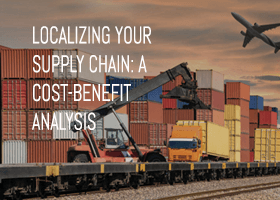Crises can reveal weaknesses and, as the coronavirus spread around the globe, it made clear the lack of visibility many businesses had into offshore suppliers and manufacturers and demonstrated the fragility of their supply chains. It was a sobering wakeup call 30 years after many companies expanded their supply chains abroad to take advantage of much lower costs. In a May survey by the Institute for Supply Management, 97% of respondents said the coronavirus impacted their supply chain and 36% dealt with disruptions. Yet, as of March, 44% of respondents had no plan to overcome these disruptions. In other words, these companies could not maintain production at normal levels if, for example, they relied on a single supplier in China’s Hubei province, where the virus first surfaced.
The lost revenue that resulted sparked a reckoning to improve supply chain resilience—55% of supply chain leaders told Gartner they expect to have a
highly resilient supply chain within two to three years, up from 21% that have such a supply chain today. Building resilience requires establishing relationships with multiple suppliers and manufacturers. It also requires complete visibility
into the source of each component that goes into your goods, and the path those components take to your facility. That’s where traceability comes in:
a company must be able to track a product as it evolves from raw material to manufactured good and is then shipped to a store or consumer. This call for greater supply chain resilience and traceability has led many businesses to consider moving pieces of their supply chain to local regions—for U.S. companies, that means back to North America. “Onshoring” and local sourcing makes companies more nimble and therefore more resilient when the unexpected strikes, because a supply chain located closer to home is shorter, making full traceability easier. It also appeals to an increasing number of consumers who want to
purchase products made locally. Businesses onshoring (or reshoring if they previously had production locally) their supply chain is not an all-or-nothing proposition. A manufacturer could simply add secondary suppliers domestically or start using a contract manufacturer, say in Mexico or the U.S., to mitigate
the impact of another disruption while maintaining partners abroad. That’s more likely than companies uprooting a proven operation in Asia and replacing it with new suppliers, manufacturers and distributors in North America.
14 min read
Localizing Your Supply Chain: A Cost-Benefit Analysis
By Tekiio Editorial Board on Oct 8, 2020 6:24:52 PM

